Disadvantages Of Halogen Ovens – What Are The Problems And Dangers?
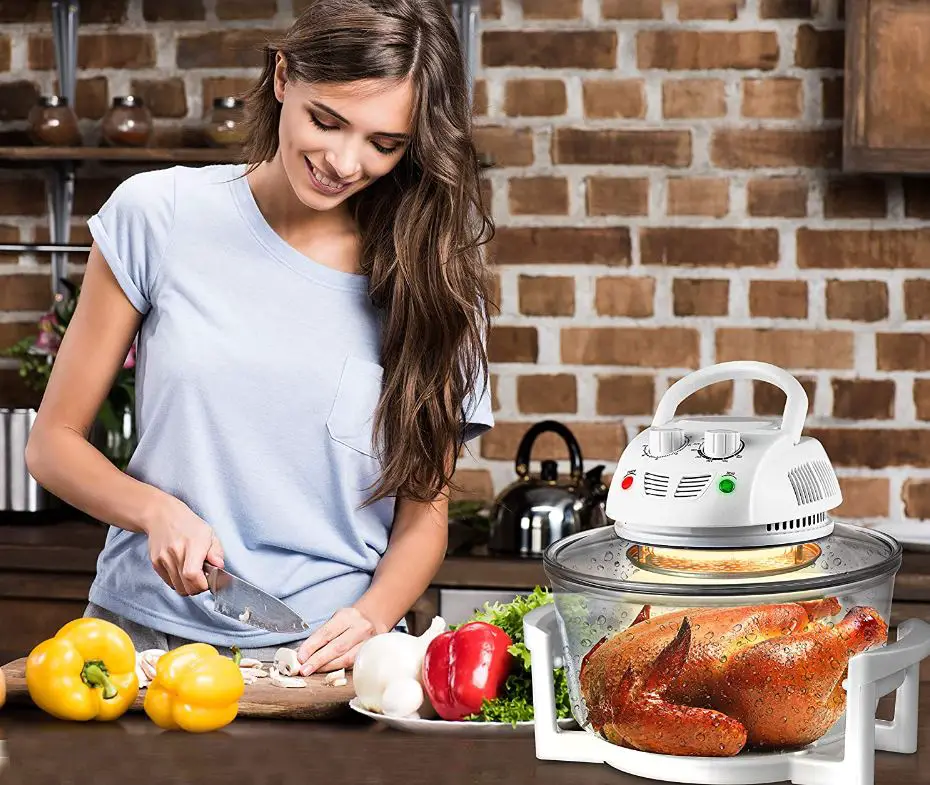
In recent years, there have been many challengers to the traditional gas ovens that most of us are used to cooking with. From air fryers to toaster ovens, in 2022 there is no shortage of alternative cooking appliances.
But are all of them viable? The short answer is, no. Not for everyone anyway. The most important thing about choosing an alternative cooking appliance is making sure that it fits your needs and your lifestyle.
In that vein, today we will be taking a look at halogen ovens, discussing their pros and cons, and even highlighting some of the best ones currently on the market. The goal today is to educate you on the common problems, dangers and benefits of these ovens and to help you determine if one is right for you.
What Are Halogen Ovens & How Do They Work?
As the name suggests, halogen ovens utilize a halogen light bulb to produce heat. The bulb produces the heat that cooks the food and an onboard fan circulates the air to cook the food evenly.
Halogen ovens are typically small, electric, countertop appliances that need to be plugged in.
They are typically much smaller than traditional gas ovens and can cook food much quicker – though their internal cooking capacity tends to be much less. Halogen ovens produce infrared radiation which actually passes through the particles of the food.
Your average halogen oven will consist of a large glass bowl, a halogen bulb, a fan and a thermostat that allows you to control the cooking temperature.
Halogen Oven Overview
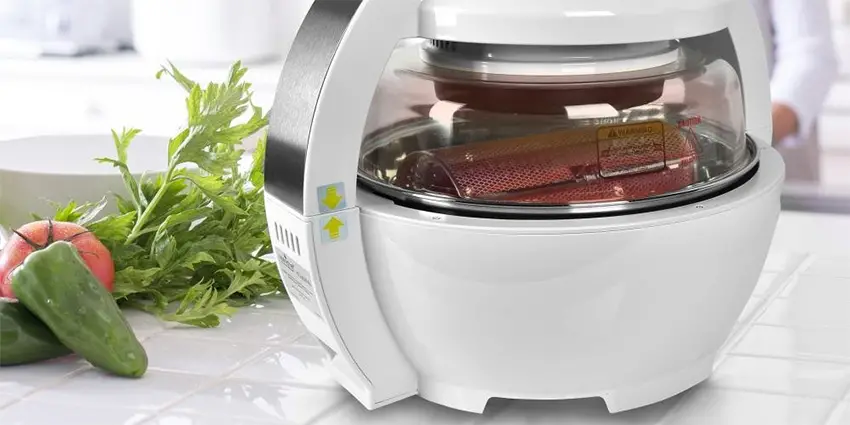
While halogen ovens are compact, convenient and can cook food relatively quickly they have some key drawbacks that every consumer needs to know about. Halogen ovens are typically smaller-capacity ovens that are suitable for families of no more than 4. They also struggle to cook certain foods.
Disadvantages of Halogen Ovens
- Upfront Cost – Halogen ovens aren’t exactly the most popular kinds of ovens on the market. So they are still relatively expensive. The price will surely be high if you require one with a lot of accessories and premium features.
- Smaller Cooking Capacity – The smaller cooking capacity of halogen ovens (when compared to gas ovens) is a big deal for many home chefs. You won’t be cooking Thanksgiving dinner in a halogen oven and they typically can’ cook for more than 4 people at a time.
- Halogen Bulbs Can Blow Easily – Halogen bulbs tend to be very delicate and if you cook at home very often with one, you may need to replace the bulb quite often.
- Not Always Easy to Repair – Because halogen ovens are still not very common, repairmen tend to cost a premium for repairs of these appliances.
- Missing the Process – Some cooking enthusiasts write off halogen ovens completely because they lack the familiarity and feel of the traditional cooking process. For instance, you can’t char your meats with a halogen oven.
- Slower Cooking – One of the main benefits of halogen ovens is that they’re supposed to cook food faster. However, if you are using the wrong utensils and cooking vessels, the infrared heat can actually focus on the vessel instead of the actual food – resulting in slower cooking times.
- Magnetic Utensils Only – You may have to switch up your cooking utensils and vessels if you buy a halogen ovens. That’s because halogen ovens work most efficiently when you use magnetic vessels and utensils like stainless steel and cast iron. That’s why one key disadvantage to using a halogen oven is that you may need to buy all new pots and pans. Aluminum, copper and glass cooking vessels are not compatible with halogen ovens.
- Hard to Gauge Heat and Cooking Times – Infrared heat tends to be much harder to gauge because it heats the objects directly and not so much the space around it. For new users of halogen ovens, it can be very easy to accidentally burn food.
- Won’t Work in A Power Outage – Because halogen ovens rely on electricity, you won’t be able to use one in case of a power outage.
- Potentially Bad for the Environment – The radiation produced by halogen ovens may have detrimental effects on the immediate environment.
Problems & Dangers of Halogen Ovens
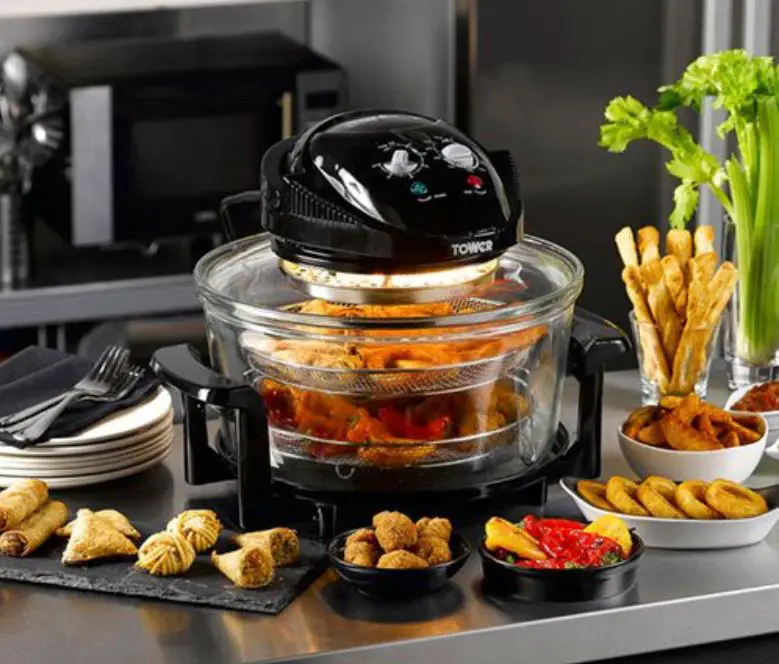
In addition to the practical disadvantages of halogen ovens, there are some safety and health risks that have been associated with them as well. Take a look at the following (potential) problems and dangers of halogen ovens:
- Health Effects – The radiation produced by halogen ovens may cause immune system problems, adverse ocular effects and adverse cardiac effects. Furthermore, radiation heating may expose your foods to more carcinogens.
- Burn Risks – Even though halogen ovens don’t heat up themselves, they can still make the utensils and cooking vessels you use very hot.
- Electric Shock Risk – If the power cord of a halogen oven is damaged or becomes wet, it can pose an electric shock risk when you touch it.
- Food Contamination – Dry heating methods such as the infrared heating used in halogen ovens can expose your foods to certain contaminants. For example, there have been carcinogen warnings associated with cooking with halogen ovens.
Benefits of Halogen Ovens
- Faster Cooking – As long as you use compatible, magnetic cooking vessels, halogen ovens can cook much quicker than traditional gas ovens. That’s because the food is heated directly – not the space around it.
- Utilities – If natural gas is expensive in your region of the country, then you may actually save money by using a halogen oven which runs on electricity.
- Less Burning Risk – By and large, there is less of a chance that you burn yourself with a halogen oven than a traditional oven. Again, this is because the objects in the oven are heated directly and not the oven itself.
- Transparency – The bowls that comprise most halogen ovens are typically made of transparent glass. This allows you to see your food clearly as it is being cooked.
- Versatility – You can cook a wide variety of foods in a halogen ovens including but not limited to frozen dinners, roasts, meats, pizzas and cakes.
Comparisons
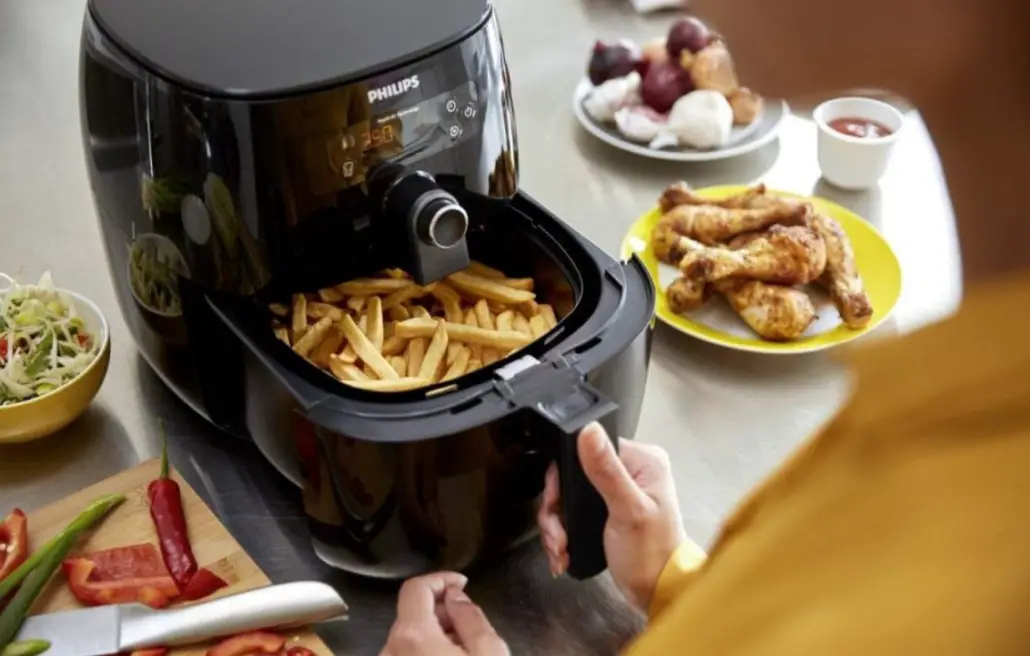
Halogen Ovens Vs Air Fryers
In terms of cooking variety, air fryers are more valuable. For instance, you can dehydrate foods in an air fryer; but you can’t in a halogen oven. Air fryers typically have multiple cooking modes and some may be combination pressure cookers as well.
Halogen Ovens Vs Microwaves
Microwaves tend to leave cold spots in food because of the electromagnetic radiation heating method they employ. Halogen ovens tend to cook food more evenly than microwaves and have more applications.
Halogen Ovens Vs Slow Cookers
Slow cookers tend to produce juicier and more tender meats than halogen ovens. If you cook a lot of meat and care about the quality of meat you eat, a slow cooker would be better for you. However, as the name indicates, a slow cooker will take significantly longer to prepare meals than a halogen oven.
Three Halogen Ovens to Consider
Rosewill Infrared Halogen Stainless Steel Extender Ring Convection Oven
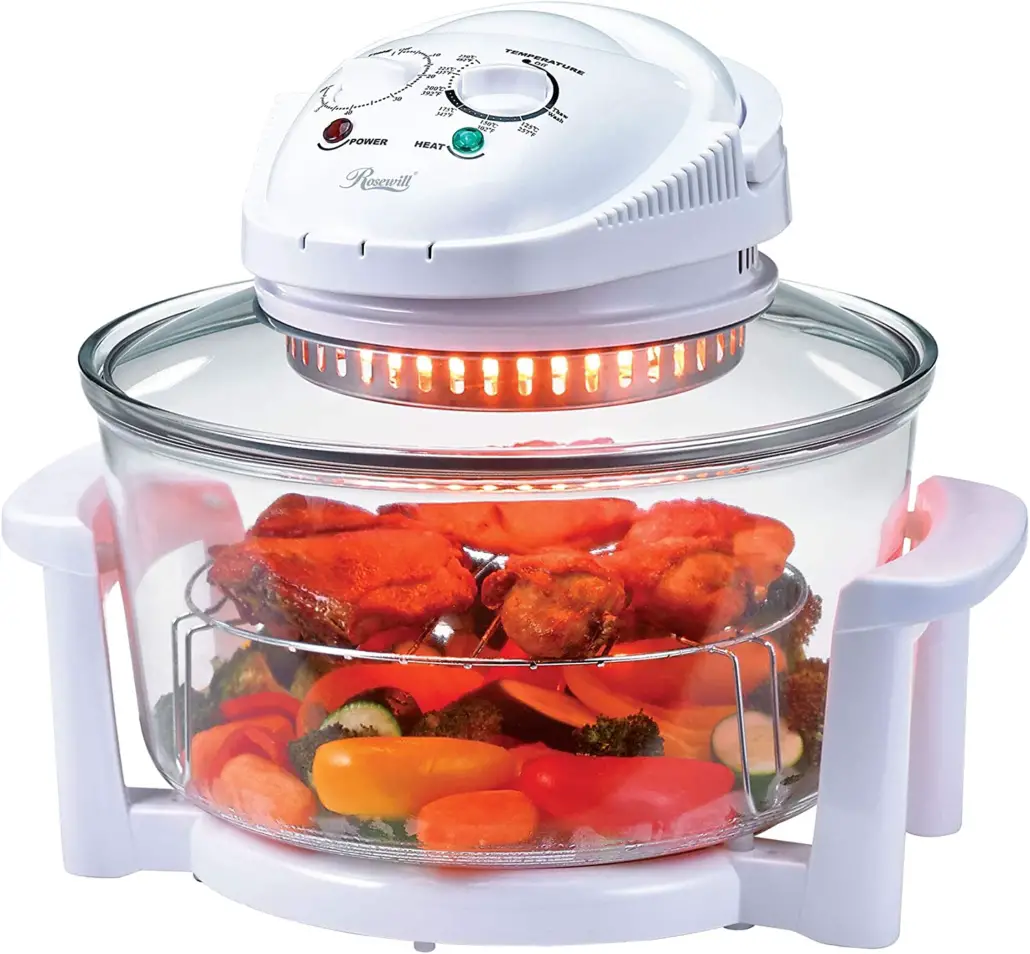
The Rosewill Infrared Halogen Stainless Steel Extender Ring Convection Oven is a very easy halogen oven to use with a simple knob control: one for the temperature and one for timing.
It comes with 2 cooking racks, a stand for the cooking chamber, a lid holder and tongs. It has an 18 quart cooking capacity and an output of 1200 watts.
Pros:
- Easy to use
- Helpful accessories
Cons:
- Makes odd noises sometimes
Overall Score: 94/100
Check Out More Reviews Here:
Classic Cuisine 12-17 Quart 1200W Halogen Tabletop Oven

The great thing about this halogen oven is that it comes with its own frying pan so you can more or less air fry foods. It has a 12 quart capacity cooking chamber that’s completely transparent so you can keep a close eye on your culinary creations as they cook.
The cooking chamber is also dishwasher safe. Another cool thing is that the Classic Cuisine 12-17 Quart 1200W Halogen Tabletop Oven has a steam setting to make it easier to prepare more nutritious meals.
Pros:
- Compact design
- Stainless steel parts
Cons:
- Short power cable
Overall Score: 95/100
Check Out More Reviews Here:
Nutrichef PKAIRFR4
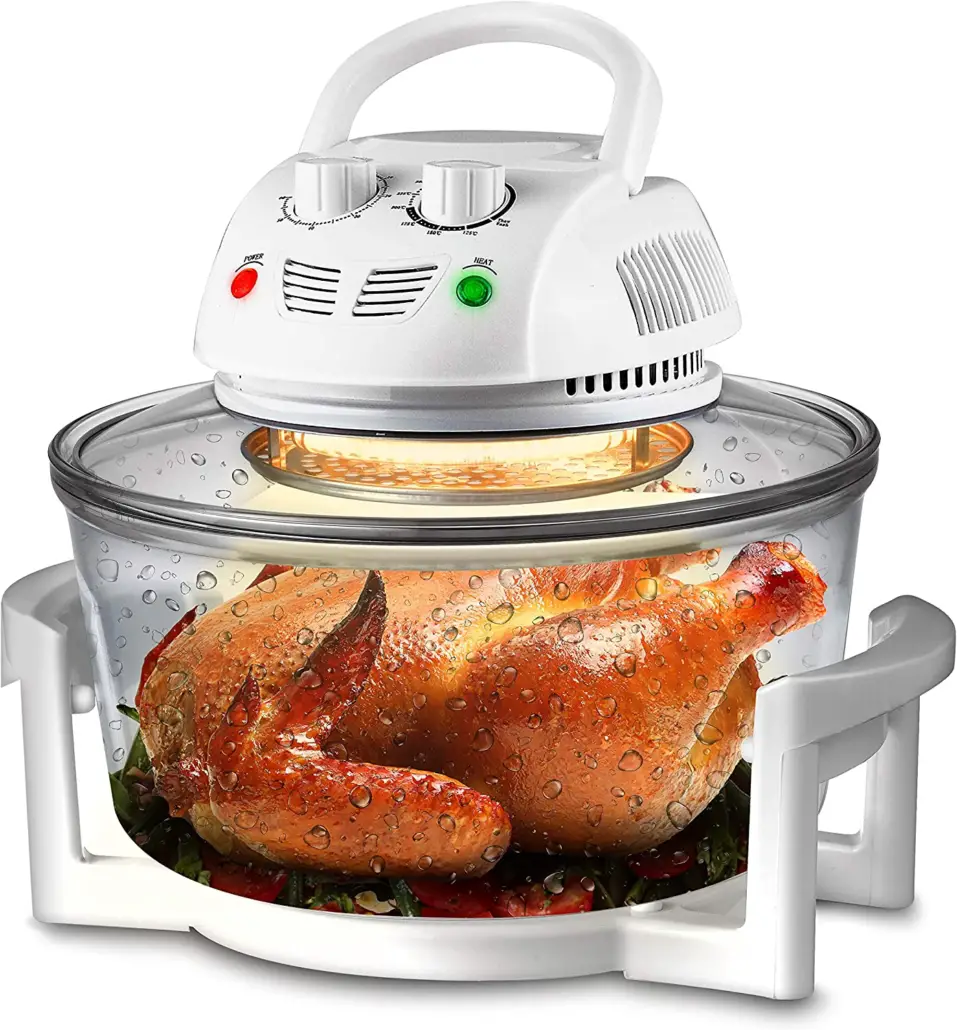
The Nutrichef PKAIRFR4 features a 13 quart cooking chamber made of transparent glass. With this size, you can cook a small turkey or chicken. You can use this countertop appliance for air frying, broiling, baking and steaming.
This oven is very easy to use even if you have never used a halogen oven before. Nutrichef PKAIRFR4. So this would be a good choice if this is your first time buying one of these appliances.
Pros:
- Affordable
- Good safety features
Cons:
- Delicate glass chamber
Overall Score: 94/100
Check Out More Reviews Here:
Halogen Oven FAQs
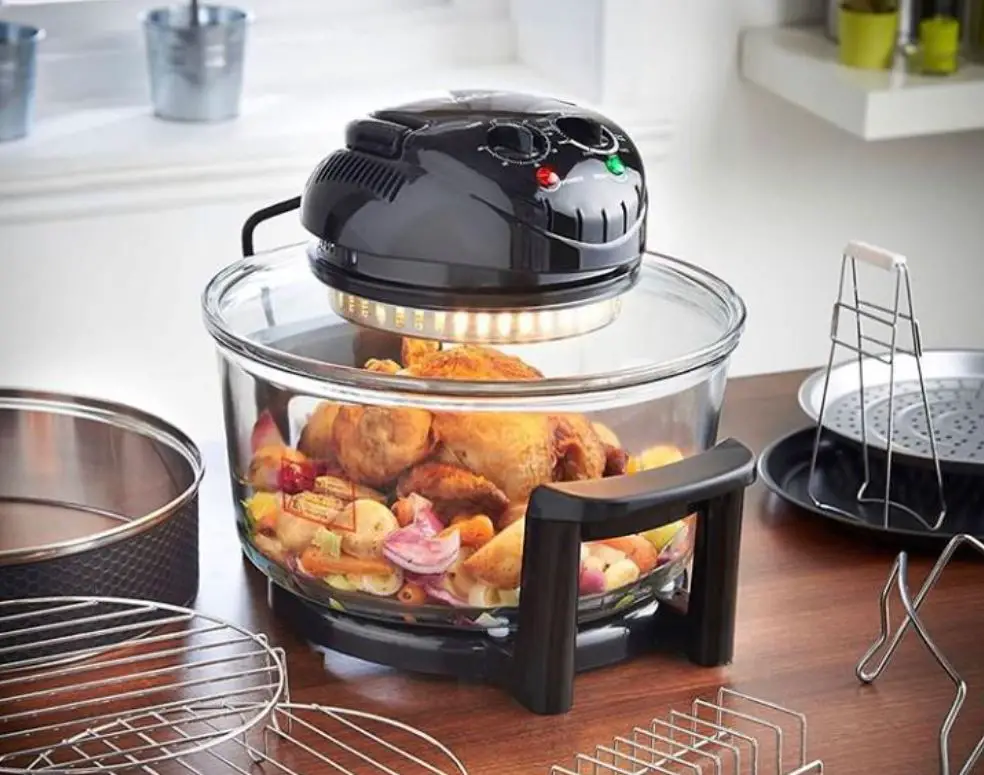
Q: Can you cook in the bottom of a halogen oven?
The bottom of a halogen oven is usually reserved for baking, roasting, defrosting, steaming and re-heating.
Q: Do you preheat a halogen oven?
There is no need to preheat a halogen oven because they get foods to the desired temperature very quickly.
Q: Can you use foil in a halogen oven?
Yes. In fact, many people use foil to wrap foods cooked in a halogen oven to prevent them from browning too quickly. Just be sure to wrap the food securely as the fan inside halogen ovens can blow the foil off.
Q: Can you cook frozen food in a halogen oven?
Yes. In fact, it is very efficient to cook frozen foods in halogen ovens because they can heat up quicker than microwaves and traditional ovens.
Q: Can you cook frozen chips in a halogen oven?
Absolutely. The same concept applies for frozen chips (or fries as we call them here stateside) as it does for frozen foods.
Q: How long does a chicken take to cook in a halogen oven?
If you are cooking a whole chicken at the recommended temperature of 400 degrees Fahrenheit, then it should take about 40-50 minutes to cook. Also, be sure to cook the chicken on the bottom rack and use an extender ring if available.
Q: Can you make toast in a halogen oven?
Yes. It’s best to load your bread on the top rack of your halogen oven.
Q: Can you use a halogen oven as an air fryer?
Yes. In fact, many modern halogen ovens come with an air fryer setting. Halogen ovens excel at creating crispy, fried foods with minimal oil.
Q: Do halogen ovens use a lot of electricity?
Halogen ovens use about the same amount of electricity as conventional ovens. They can heat up very quickly so depending on the dish, they may be more energy-efficient because they take less time to cook certain foods.
Q: Can you cook steak in a halogen oven?
Yes, you can cook most types of meat in a halogen oven, including cuts of steak.
Q: Can you cook everything in a halogen oven?
You can cook most types of food in a halogen oven including frozen foods, pizza, bread, cakes, cookies, processed meats, red meat, chicken, fish, vegetables, tubers and you can use them to reheat leftovers.
Q: Is a halogen oven good for health?
Cooking with a halogen oven can be healthy because you won’t need to use a lot of oil -similar to an air fryer.
Q: Can you fry an egg in a halogen oven?
As long as you use the frying pan your oven came with or a compatible one, you should be able to easily fry an egg in a halogen oven.
Q: Can I use silicone bakeware in a halogen oven?
Yes, as long as you set it to the proper temperature.
Q: How much quicker is a halogen oven?
Your typical halogen oven will reach temperature 20%-60% faster than a conventional oven.
Final Thoughts
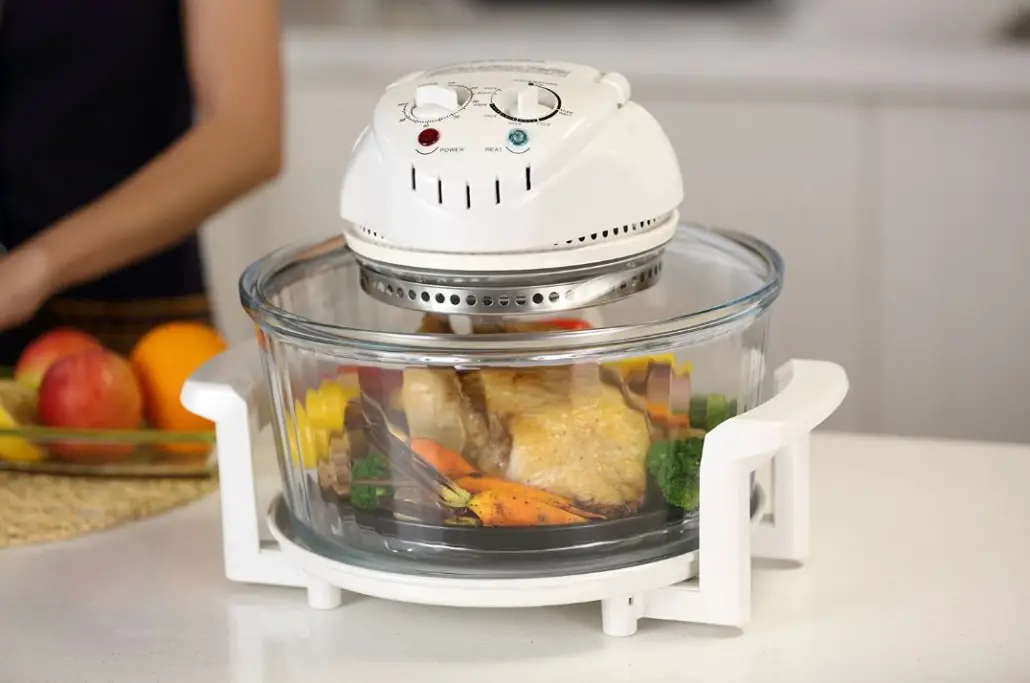
Despite all the disadvantages of halogen ovens, they should still be on your radar if you have a small kitchen or don’t normally cook for a lot of people. Just remember that you may have to switch up your utensils and cookware.
If you are ready for the next generation of convection cooking though, we recommend checking out the halogen ovens we highlighted above!



